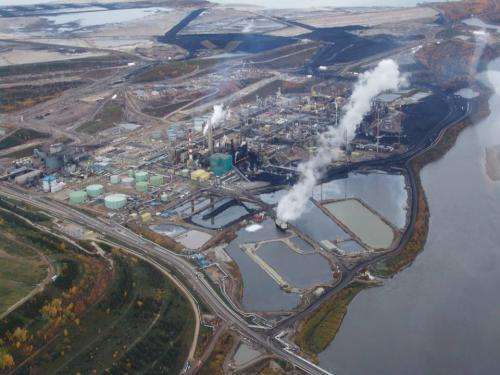Novel sampling method reveals oil sand mining is not polluting Athabasca Delta

A new study into the pre-industrial baseline levels of heavy metals in sediment carried by the Athabasca River shows that emissions from the Alberta oil sands and other human activities have not yet increased the concentrations travelling to the Athabasca Delta around 200km from the oil sands.
The study, carried out by scientists at the University of Waterloo and Wilfrid Laurier University, developed a novel approach that can accurately determine the pre-industrial baseline levels of metals in river sediment. This approach allows regulators to instantly determine if values from routine monitoring programs contain evidence of man-made pollution.
Normally, rivers are monitored for pollution upstream and downstream of a pollution source. But this method is problematic in an area like the Athabasca oil sands, where erosion of bitumen-rich riverbanks naturally releases substantial quantities of polycyclic aromatic hydrocarbons and metals into the river.
"The detection of river pollution is often hampered by a lack of knowledge about pre-industrial contaminant levels," said Johan Wiklund, lead author on the study and postdoctoral researcher in the Department of Biology at the University of Waterloo. "This new methodology can be applied to any river around the world."
The study, which appears in the peer-reviewed scientific journal Environmental Research Letters, measured eight priority metals, including nickel, vanadium and zinc, in sediments taken from floodplain lakes in the Athabasca Delta that were supplied by river floodwaters before the industrial era (1700-1920).
The researchers normalized their data to lithium concentrations to adjust for confounding differences caused by variations in river flow and sediment grain size. They then compared this natural baseline to metal concentrations measured by the multi-stakeholder oil sands monitoring organization RAMP (Regional Aquatics Monitoring Program) in sediments collected along the Athabasca River between 2010 and 2013 .
Results show that the concentration of metal contaminants travelling via the Athabasca River to its terminus at the Athabasca Delta has not yet increased as a result of Alberta oil sands development or other human activities.
Roly Hall collects river sediment samples
Professor Roland Hall (left) collects river sediment samples from the Athabasca River delta.
The sampling area, located 200 kilometers north of the oil sands, is home to a community of Athabasca Chipewyan First Nation, Mikisew Cree First Nation and Métis residents who have expressed concern that pollutants from the oil sands are reaching their traditional food sources via the Athabasca River.
"This research is an important step in learning the extent of the oil sands' industrial impact on the region," said Professor Roland Hall, a biologist in the Faculty of Science at Waterloo. "Our hope is that these findings will now help other researchers better understand what might be the cause of concerns for people living in the region."
Next, the research team plans to create pre-industrial baselines for metals in the Athabasca River sediment further upstream where oil sands mining and processing activities occur.
"Our study does not address concerns of river sediment pollution closer to the oil sands development," said Professor Hall. "Up until now, pre-industrial baseline levels of contaminants were not known, which has undermined the ability of monitoring programs such as RAMP to determine if oil sands development has been polluting the river. We now have a way to obtain these critical baseline data."
More information: Use of pre-industrial floodplain lake sediments to establish baseline river metal concentrations downstream of Alberta oil sands: a new approach for detecting pollution of rivers, Johan A Wiklund et al 2014 Environ. Res. Lett. 9 124019. DOI: 10.1088/1748-9326/9/12/124019
Journal information: Environmental Research Letters
Provided by University of Waterloo

















